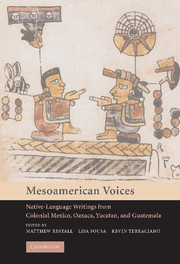Book contents
- Frontmatter
- Contents
- List of Documents and Images
- Preface and Acknowledgments
- Colonial Mesoamerica
- PART ONE
- PART TWO
- 3 Views of the Conquest
- 4 Political Life
- 5 Household and Land
- 6 Society and Gender
- 7 Crime and Punishment
- 8 Religious Life
- 9 Rhetoric and Moral Philosophy
- Glossary
- References and Readings
- Index
7 - Crime and Punishment
Published online by Cambridge University Press: 05 October 2014
- Frontmatter
- Contents
- List of Documents and Images
- Preface and Acknowledgments
- Colonial Mesoamerica
- PART ONE
- PART TWO
- 3 Views of the Conquest
- 4 Political Life
- 5 Household and Land
- 6 Society and Gender
- 7 Crime and Punishment
- 8 Religious Life
- 9 Rhetoric and Moral Philosophy
- Glossary
- References and Readings
- Index
Summary
New Spain was governed by a complex legal system that incorporated both indigenous and Spanish laws and customs, and involved various types of courts with overlapping jurisdictions. Native officials continued to handle many conflicts according to local custom, often without a written record. But the alcalde mayor (chief Spanish administrator and first-instance judge in a given jurisdiction) would get involved if the crime was of a violent or serious nature, if a Spaniard was involved, or if the aggrieved party chose to approach him with a complaint. In handling a legal dispute, whether civil or criminal, the alcalde mayor and his staff began a formal investigation by assembling evidence and obtaining preliminary declarations from the parties involved, making arrests, if necessary, and scheduling a hearing with witnesses. Thus, criminal proceedings involving native peoples often originated at the level of the local cabildo and proceeded to the alcalde mayor. When a serious crime such as homicide was committed in a community, the nearest cabildo officials investigated the crime, made arrests, and sent the Spanish alcalde mayor a brief written report of the crime. Thereafter, the entire proceedings were recorded in Spanish by notaries attached to the staff of the alcalde mayor with the aid of translators (as in documents 7.2 and 7.8).
Spanish criminal investigations followed specific rules and guidelines, often structured around a set of questions prepared in advance by lawyers and other colonial officials. But sometimes the native officials recorded confessions or statements from victims and suspects.
- Type
- Chapter
- Information
- Mesoamerican VoicesNative Language Writings from Colonial Mexico, Yucatan, and Guatemala, pp. 158 - 173Publisher: Cambridge University PressPrint publication year: 2005



